In Silico Identification and Validation of Pyroptosis-Related Genes in Chlamydia Respiratory Infection
Abstract
:1. Introduction
2. Results
2.1. Screening of 13 Differentially Expressed Pyroptosis-Related Genes
2.2. Functional and Pathway Enrichment Analysis of 13 Differentially Expressed Pyroptosis-Related Genes
2.3. Construction of PPI Network of 13 Differentially Expressed Pyroptosis-Related Genes
2.4. Validation of Pyroptosis-Related Genes
2.5. Construction of ceRNA Regulatory Network for Key Pyroptosis-Related Genes
2.6. Immuno-correlation Analysis of Key Pyroptosis-Related Genes
3. Discussion
4. Materials and Methods
4.1. Mice
4.2. C. muridarum Respiratory Tract Infection Models
4.3. RNA Extraction from Lung Tissues and Sample Preparation for Transcriptome Sequencing
4.4. Principal Component Analysis
4.5. Identifying Differently Expressed Pyroptosis-Related Genes
4.6. Function and Pathway Enrichment Analysis
4.7. Construction of PPI Network and Module Analyses
4.8. qPCR
4.9. Western Blot Analysis
4.10. Construction of the ceRNA-Regulating Network
4.11. Analysis of Immune Cell Infiltration
4.12. Statistical Analysis
Supplementary Materials
Author Contributions
Funding
Institutional Review Board Statement
Informed Consent Statement
Data Availability Statement
Acknowledgments
Conflicts of Interest
References
- Elwell, C.; Mirrashidi, K.; Engel, J. Chlamydia cell biology and pathogenesis. Nat. Rev. Microbiol. 2016, 14, 385–400. [Google Scholar] [CrossRef] [PubMed]
- Gitsels, A.; Van Lent, S.; Sanders, N.; Vanrompay, D. Chlamydia: What is on the outside does matter. Crit. Rev. Microbiol. 2020, 46, 100–119. [Google Scholar] [CrossRef]
- Cossé, M.M.; Hayward, R.D.; Subtil, A. One Face of Chlamydia trachomatis: The Infectious Elementary Body. Curr. Top. Microbiol. Immunol. 2018, 412, 35–58. [Google Scholar] [CrossRef] [PubMed]
- Bayramova, F.; Jacquier, N.; Greub, G. Insight in the biology of Chlamydia-related bacteria. Microbes Infect. 2018, 20, 432–440. [Google Scholar] [CrossRef]
- Marti, H.; Suchland, R.J.; Rockey, D.D. The Impact of Lateral Gene Transfer in Chlamydia. Front. Cell. Infect. Microbiol. 2022, 12, 861899. [Google Scholar] [CrossRef] [PubMed]
- Gupta, A.; Shamsi, F.; Altemose, N.; Dorlhiac, G.F.; Cypess, A.M.; White, A.P.; Yosef, N.; Patti, M.E.; Tseng, Y.H.; Streets, A. Characterization of transcript enrichment and detection bias in single-nucleus RNA-seq for mapping of distinct human adipocyte lineages. Genome Res. 2022, 32, 242–257. [Google Scholar] [CrossRef]
- Yu, P.; Zhang, X.; Liu, N.; Tang, L.; Peng, C.; Chen, X. Pyroptosis: Mechanisms and diseases. Signal. Transduct. Target Ther. 2021, 6, 128. [Google Scholar] [CrossRef]
- Tang, R.; Xu, J.; Zhang, B.; Liu, J.; Liang, C.; Hua, J.; Meng, Q.; Yu, X.; Shi, S. Ferroptosis, necroptosis, and pyroptosis in anticancer immunity. J. Hematol. Oncol. 2020, 13, 110. [Google Scholar] [CrossRef]
- Kovacs, S.B.; Miao, E.A. Gasdermins: Effectors of Pyroptosis. Trends Cell Biol. 2017, 27, 673–684. [Google Scholar] [CrossRef]
- Deng, W.; Bai, Y.; Deng, F.; Pan, Y.; Mei, S.; Zheng, Z.; Min, R.; Wu, Z.; Li, W.; Miao, R.; et al. Streptococcal pyrogenic exotoxin B cleaves GSDMA and triggers pyroptosis. Nature 2022, 602, 496–502. [Google Scholar] [CrossRef]
- Wei, X.; Xie, F.; Zhou, X.; Wu, Y.; Yan, H.; Liu, T.; Huang, J.; Wang, F.; Zhou, F.; Zhang, L. Role of pyroptosis in inflammation and cancer. Cell. Mol. Immunol. 2022, 19, 971–992. [Google Scholar] [CrossRef] [PubMed]
- Downs, K.P.; Nguyen, H.; Dorfleutner, A.; Stehlik, C. An overview of the non-canonical inflammasome. Mol. Aspects Med. 2020, 76, 100924. [Google Scholar] [CrossRef]
- Kayagaki, N.; Stowe, I.B.; Lee, B.L.; O’Rourke, K.; Anderson, K.; Warming, S.; Cuellar, T.; Haley, B.; Roose-Girma, M.; Phung, Q.T.; et al. Caspase-11 cleaves gasdermin D for non-canonical inflammasome signalling. Nature 2015, 526, 666–671. [Google Scholar] [CrossRef] [PubMed]
- Zeng, Z.; Li, G.; Wu, S.; Wang, Z. Role of pyroptosis in cardiovascular disease. Cell Prolif. 2019, 52, e12563. [Google Scholar] [CrossRef]
- Tan, C.C.; Zhang, J.G.; Tan, M.S.; Chen, H.; Meng, D.W.; Jiang, T.; Meng, X.F.; Li, Y.; Sun, Z.; Li, M.M.; et al. NLRP1 inflammasome is activated in patients with medial temporal lobe epilepsy and contributes to neuronal pyroptosis in amygdala kindling-induced rat model. J. Neuroinflamm. 2015, 12, 18. [Google Scholar] [CrossRef]
- Messaoud-Nacer, Y.; Culerier, E.; Rose, S.; Maillet, I.; Rouxel, N.; Briault, S.; Ryffel, B.; Quesniaux, V.F.J.; Togbe, D. STING agonist diABZI induces PANoptosis and DNA mediated acute respiratory distress syndrome (ARDS). Cell Death Dis. 2022, 13, 269. [Google Scholar] [CrossRef]
- Sauler, M.; Bazan, I.S.; Lee, P.J. Cell Death in the Lung: The Apoptosis-Necroptosis Axis. Annu. Rev. Physiol. 2019, 81, 375–402. [Google Scholar] [CrossRef]
- Butcher, R.; Handley, B.; Garae, M.; Taoaba, R.; Pickering, H.; Bong, A.; Sokana, O.; Burton, M.J.; Sepúlveda, N.; Cama, A.; et al. Ocular Chlamydia trachomatis infection, anti-Pgp3 antibodies and conjunctival scarring in Vanuatu and Tarawa, Kiribati before antibiotic treatment for trachoma. J. Infect. 2020, 80, 454–461. [Google Scholar] [CrossRef]
- den Heijer, C.D.J.; Hoebe, C.; Driessen, J.H.M.; Wolffs, P.; van den Broek, I.V.F.; Hoenderboom, B.M.; Williams, R.; de Vries, F.; Dukers-Muijrers, N. Chlamydia trachomatis and the Risk of Pelvic Inflammatory Disease, Ectopic Pregnancy, and Female Infertility: A Retrospective Cohort Study Among Primary Care Patients. Clin. Infect. Dis. 2019, 69, 1517–1525. [Google Scholar] [CrossRef]
- Solomon, A.W.; Burton, M.J.; Gower, E.W.; Harding-Esch, E.M.; Oldenburg, C.E.; Taylor, H.R.; Traoré, L. Trachoma. Nat. Rev. Dis. Primers 2022, 8, 32. [Google Scholar] [CrossRef]
- Zha, X.; Yang, S.; Niu, W.; Tan, L.; Xu, Y.; Zeng, J.; Tang, Y.; Sun, L.; Pang, G.; Qiao, S.; et al. IL-27/IL-27R Mediates Protective Immunity against Chlamydial Infection by Suppressing Excessive Th17 Responses and Reducing Neutrophil Inflammation. J. Immunol. 2021, 206, 2160–2169. [Google Scholar] [CrossRef]
- Szklarczyk, D.; Gable, A.L.; Lyon, D.; Junge, A.; Wyder, S.; Huerta-Cepas, J.; Simonovic, M.; Doncheva, N.T.; Morris, J.H.; Bork, P.; et al. STRING v11: Protein-protein association networks with increased coverage, supporting functional discovery in genome-wide experimental datasets. Nucleic Acids Res. 2019, 47, D607–D613. [Google Scholar] [CrossRef]
- Hayward, R.J.; Marsh, J.W.; Humphrys, M.S.; Huston, W.M.; Myers, G.S.A. Early Transcriptional Landscapes of Chlamydia trachomatis-Infected Epithelial Cells at Single Cell Resolution. Front. Cell. Infect. Microbiol. 2019, 9, 392. [Google Scholar] [CrossRef] [PubMed]
- Virok, D.P.; Tömösi, F.; Keller-Pintér, A.; Szabó, K.; Bogdanov, A.; Poliska, S.; Rázga, Z.; Bruszel, B.; Cseh, Z.; Kókai, D.; et al. Indoleamine 2,3-Dioxygenase Cannot Inhibit Chlamydia trachomatis Growth in HL-60 Human Neutrophil Granulocytes. Front. Immunol. 2021, 12, 717311. [Google Scholar] [CrossRef] [PubMed]
- Wang, K.; Sheehan, L.; Ramirez, C.; Densi, A.; Rizvi, S.; Ekka, R.; Sütterlin, C.; Tan, M. A Reverse Genetic Approach for Studying sRNAs in Chlamydia trachomatis. mBio 2022, 13, e0086422. [Google Scholar] [CrossRef] [PubMed]
- Jiang, P.; Chen, H.; Feng, X.; Xie, H.; Jiang, M.; Xu, D.; Tang, H.; Zhang, N.; Chen, J.; Zhang, L.; et al. GSDMD-mediated pyroptosis restrains intracellular Chlamydia trachomatis growth in macrophages. Front. Cell. Infect. Microbiol. 2023, 13, 1116335. [Google Scholar] [CrossRef]
- Chu, J.; Li, X.; Qu, G.; Wang, Y.; Li, Q.; Guo, Y.; Hou, L.; Liu, J.; Eko, F.O.; He, C. Correction: Chlamydia psittaci PmpD-N modulated Chicken Macrophage Function by Triggering Th2 Polarization and the TLR2/MyD88/NF-κB Signaling Pathway. Int. J. Mol. Sci. 2020, 21, 2639. [Google Scholar] [CrossRef]
- Yang, C.; Lei, L.; Collins, J.W.M.; Briones, M.; Ma, L.; Sturdevant, G.L.; Su, H.; Kashyap, A.K.; Dorward, D.; Bock, K.W.; et al. Chlamydia evasion of neutrophil host defense results in NLRP3 dependent myeloid-mediated sterile inflammation through the purinergic P2X7 receptor. Nat. Commun. 2021, 12, 5454. [Google Scholar] [CrossRef]
- Barnett, K.C.; Ting, J.P. Mitochondrial GSDMD Pores DAMPen Pyroptosis. Immunity 2020, 52, 424–426. [Google Scholar] [CrossRef]
- Shi, J.; Gao, W.; Shao, F. Pyroptosis: Gasdermin-Mediated Programmed Necrotic Cell Death. Trends Biochem. Sci. 2017, 42, 245–254. [Google Scholar] [CrossRef]
- Wang, Y.; Gao, W.; Shi, X.; Ding, J.; Liu, W.; He, H.; Wang, K.; Shao, F. Chemotherapy drugs induce pyroptosis through caspase-3 cleavage of a gasdermin. Nature 2017, 547, 99–103. [Google Scholar] [CrossRef] [PubMed]
- Webster, S.J.; Goodall, J.C. New concepts in Chlamydia induced inflammasome responses. Microbes Infect. 2018, 20, 424–431. [Google Scholar] [CrossRef]
- Xu, B.; Jiang, M.; Chu, Y.; Wang, W.; Chen, D.; Li, X.; Zhang, Z.; Zhang, D.; Fan, D.; Nie, Y.; et al. Gasdermin D plays a key role as a pyroptosis executor of non-alcoholic steatohepatitis in humans and mice. J. Hepatol. 2018, 68, 773–782. [Google Scholar] [CrossRef]
- Hsu, S.K.; Li, C.Y.; Lin, I.L.; Syue, W.J.; Chen, Y.F.; Cheng, K.C.; Teng, Y.N.; Lin, Y.H.; Yen, C.H.; Chiu, C.C. Inflammation-related pyroptosis, a novel programmed cell death pathway, and its crosstalk with immune therapy in cancer treatment. Theranostics 2021, 11, 8813–8835. [Google Scholar] [CrossRef] [PubMed]
- Zhai, Z.; Yang, F.; Xu, W.; Han, J.; Luo, G.; Li, Y.; Zhuang, J.; Jie, H.; Li, X.; Shi, X.; et al. Attenuation of Rheumatoid Arthritis Through the Inhibition of Tumor Necrosis Factor-Induced Caspase 3/Gasdermin E-Mediated Pyroptosis. Arthritis Rheumatol. 2022, 74, 427–440. [Google Scholar] [CrossRef]
- Zhang, Z.; Zhang, Y.; Xia, S.; Kong, Q.; Li, S.; Liu, X.; Junqueira, C.; Meza-Sosa, K.F.; Mok, T.M.Y.; Ansara, J.; et al. Gasdermin E suppresses tumour growth by activating anti-tumour immunity. Nature 2020, 579, 415–420. [Google Scholar] [CrossRef] [PubMed]
- Chen, H.; Xu, Z.; Wang, Y.; Xu, J.; He, K.; Wang, H.; Bai, X.; Xiang, G. CircVAPA contributes to hyper-proliferation and inflammation of keratinocytes through miR-125b-5p/sirt6 axis in psoriasis. Int. Immunopharmacol. 2023, 115, 109632. [Google Scholar] [CrossRef]
- Shen, K.; Wang, X.; Wang, Y.; Jia, Y.; Zhang, Y.; Wang, K.; Luo, L.; Cai, W.; Li, J.; Li, S.; et al. miR-125b-5p in adipose derived stem cells exosome alleviates pulmonary microvascular endothelial cells ferroptosis via Keap1/Nrf2/GPX4 in sepsis lung injury. Redox Biol. 2023, 62, 102655. [Google Scholar] [CrossRef]
- Zheng, L.; Han, X.; Hu, Y.; Zhao, X.; Yin, L.; Xu, L.; Qi, Y.; Xu, Y.; Han, X.; Liu, K.; et al. Dioscin ameliorates intestinal ischemia/reperfusion injury via adjusting miR-351-5p/MAPK13-mediated inflammation and apoptosis. Pharmacol. Res. 2019, 139, 431–439. [Google Scholar] [CrossRef]
- Kim, R.Y.; Horvat, J.C.; Pinkerton, J.W.; Starkey, M.R.; Essilfie, A.T.; Mayall, J.R.; Nair, P.M.; Hansbro, N.G.; Jones, B.; Haw, T.J.; et al. MicroRNA-21 drives severe, steroid-insensitive experimental asthma by amplifying phosphoinositide 3-kinase-mediated suppression of histone deacetylase 2. J. Allergy Clin. Immunol. 2017, 139, 519–532. [Google Scholar] [CrossRef]
- Locati, M.; Curtale, G.; Mantovani, A. Diversity, Mechanisms, and Significance of Macrophage Plasticity. Annu. Rev. Pathol. 2020, 15, 123–147. [Google Scholar] [CrossRef]
- Yan, J.; Horng, T. Lipid Metabolism in Regulation of Macrophage Functions. Trends Cell Biol. 2020, 30, 979–989. [Google Scholar] [CrossRef] [PubMed]
- Wu, K.; Yuan, Y.; Yu, H.; Dai, X.; Wang, S.; Sun, Z.; Wang, F.; Fei, H.; Lin, Q.; Jiang, H.; et al. The gut microbial metabolite trimethylamine N-oxide aggravates GVHD by inducing M1 macrophage polarization in mice. Blood 2020, 136, 501–515. [Google Scholar] [CrossRef]
- Cabeza-Cabrerizo, M.; Cardoso, A.; Minutti, C.M.; Pereira da Costa, M.; Reis e Sousa, C. Dendritic Cells Revisited. Annu. Rev. Immunol. 2021, 39, 131–166. [Google Scholar] [CrossRef] [PubMed]
- Worbs, T.; Hammerschmidt, S.I.; Förster, R. Dendritic cell migration in health and disease. Nat. Rev. Immunol. 2017, 17, 30–48. [Google Scholar] [CrossRef] [PubMed]
- Jiao, Y.; Zhang, T.; Zhang, C.; Ji, H.; Tong, X.; Xia, R.; Wang, W.; Ma, Z.; Shi, X. Exosomal miR-30d-5p of neutrophils induces M1 macrophage polarization and primes macrophage pyroptosis in sepsis-related acute lung injury. Crit. Care 2021, 25, 356. [Google Scholar] [CrossRef] [PubMed]
- Shekhar, S.; Peng, Y.; Wang, S.; Yang, X. CD103+ lung dendritic cells (LDCs) induce stronger Th1/Th17 immunity to a bacterial lung infection than CD11b(hi) LDCs. Cell. Mol. Immunol. 2018, 15, 377–387. [Google Scholar] [CrossRef]
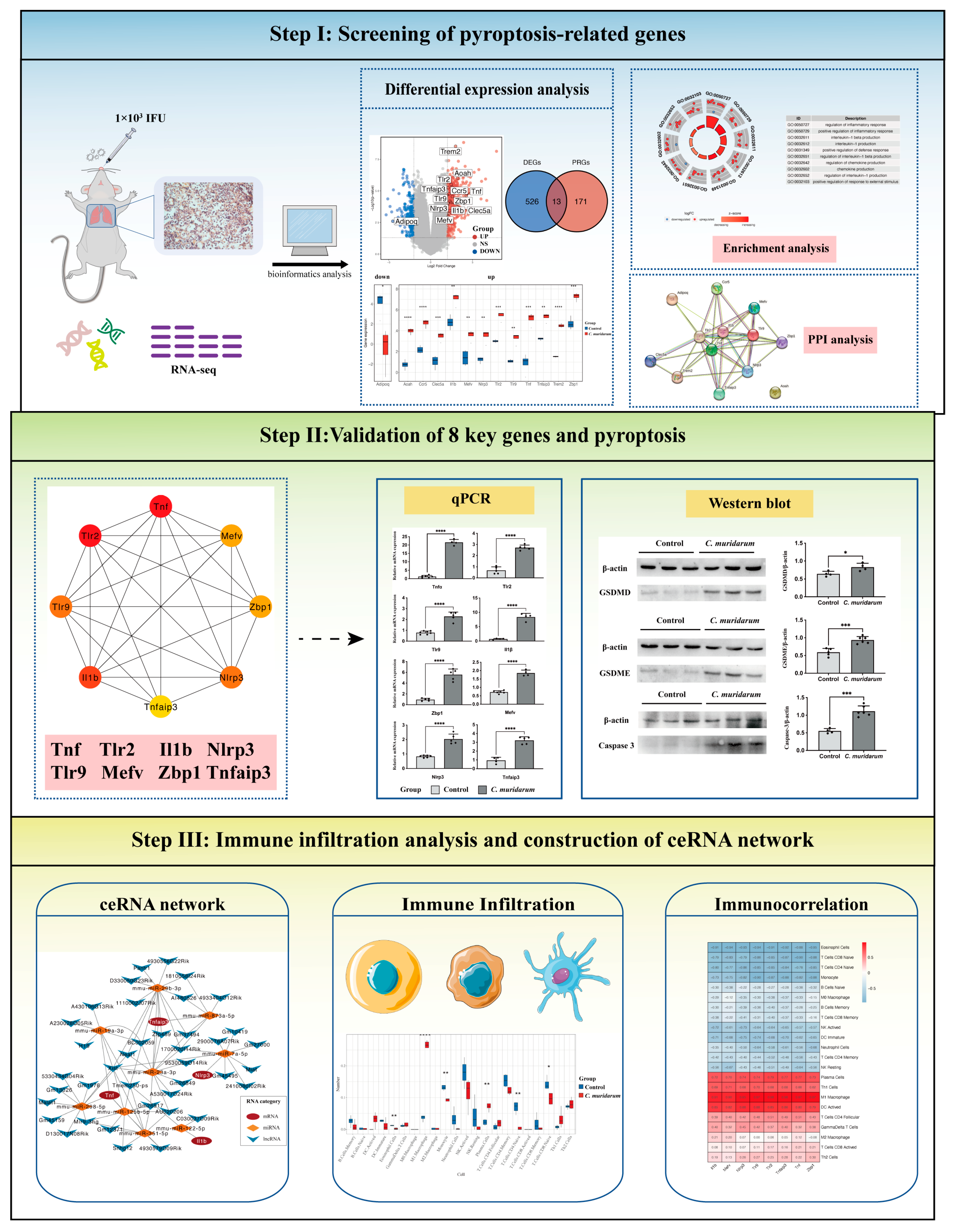
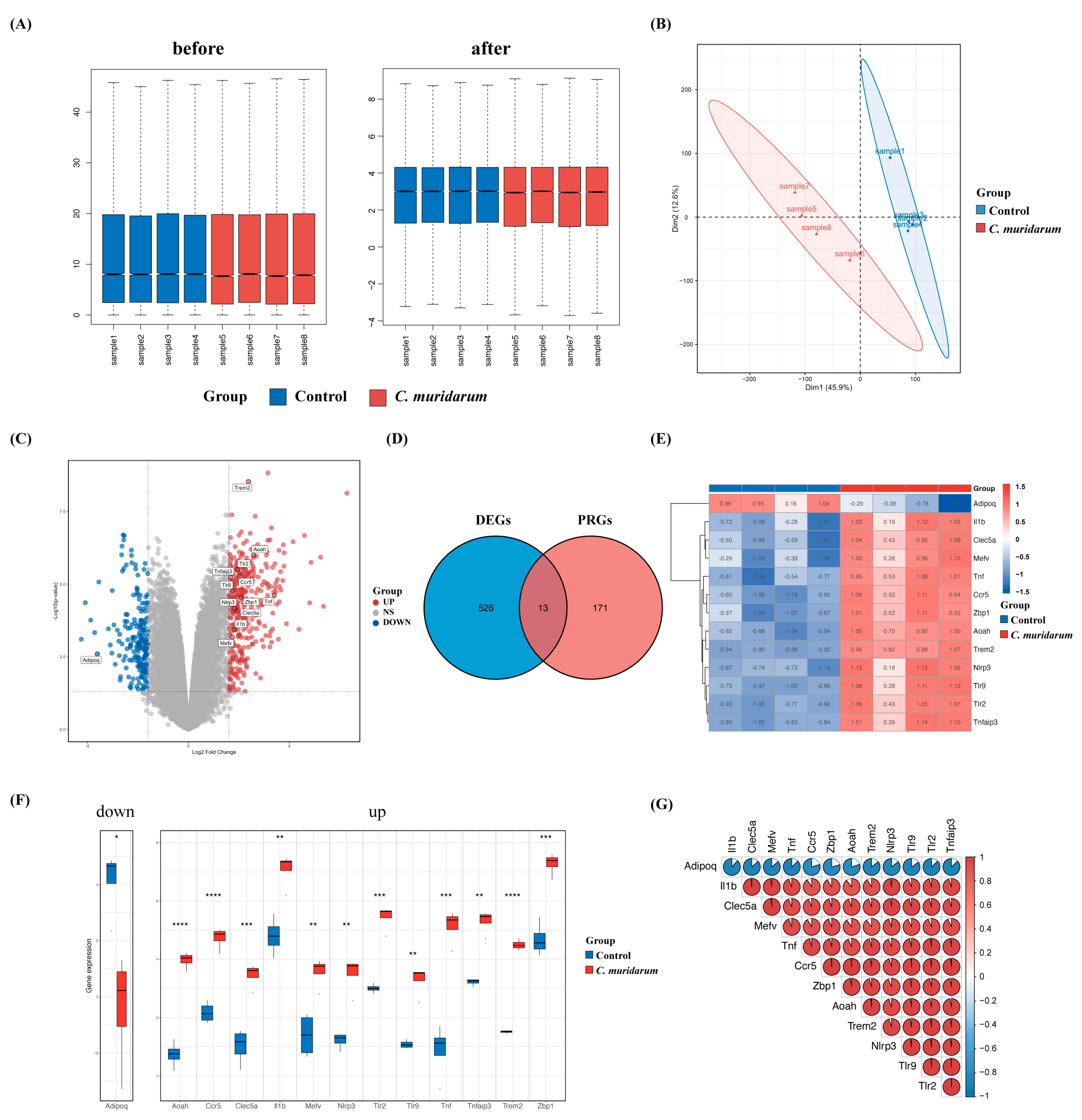
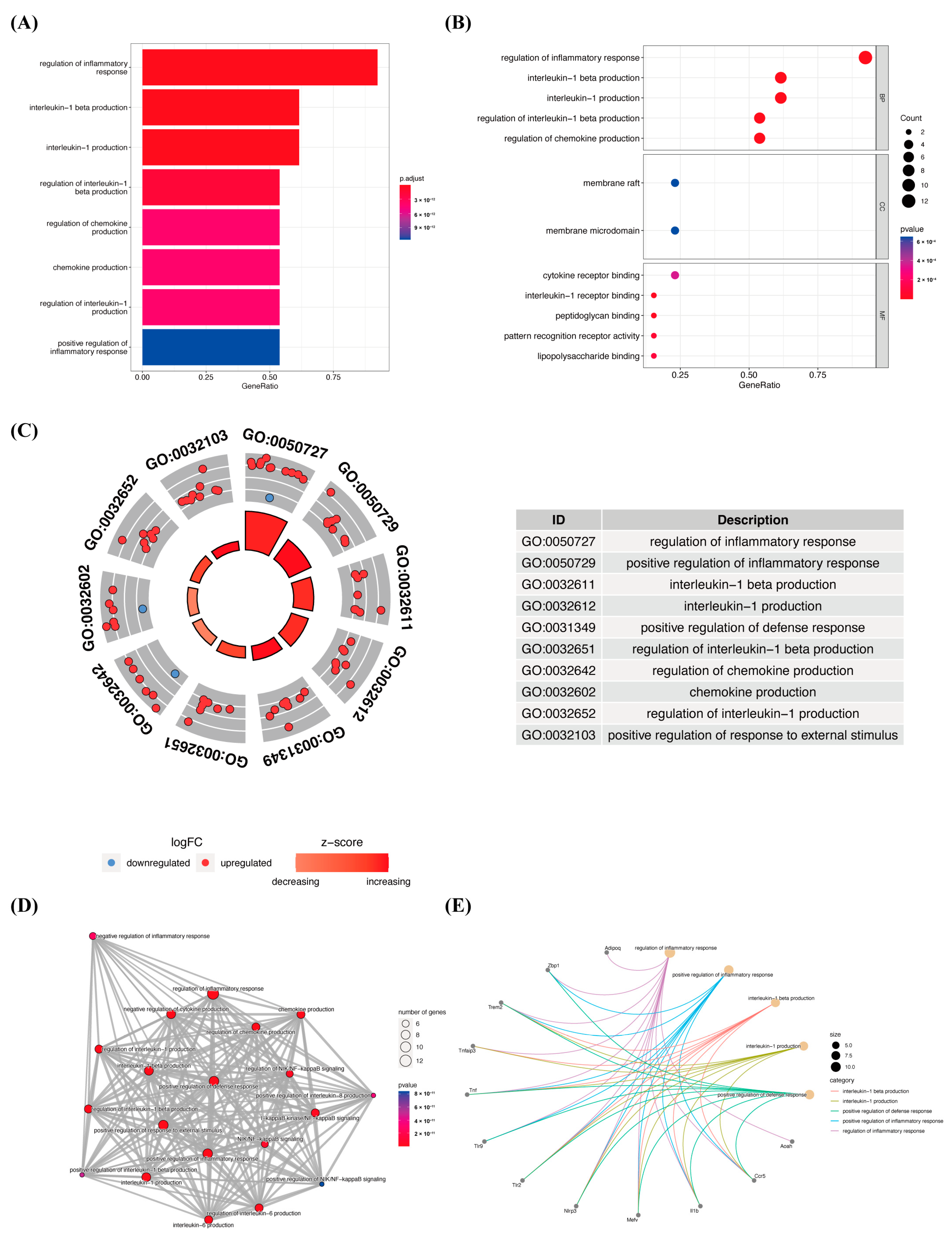
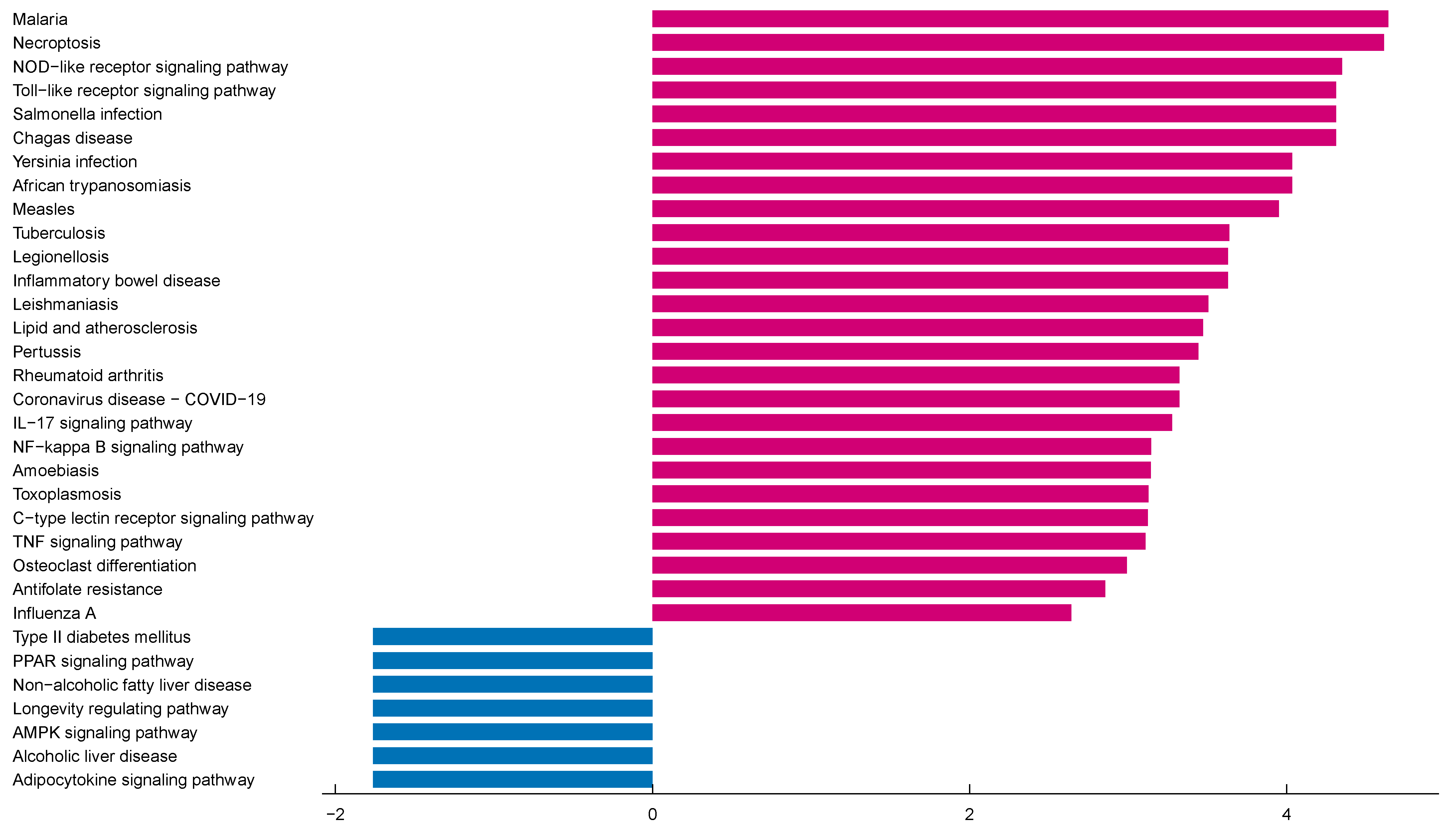

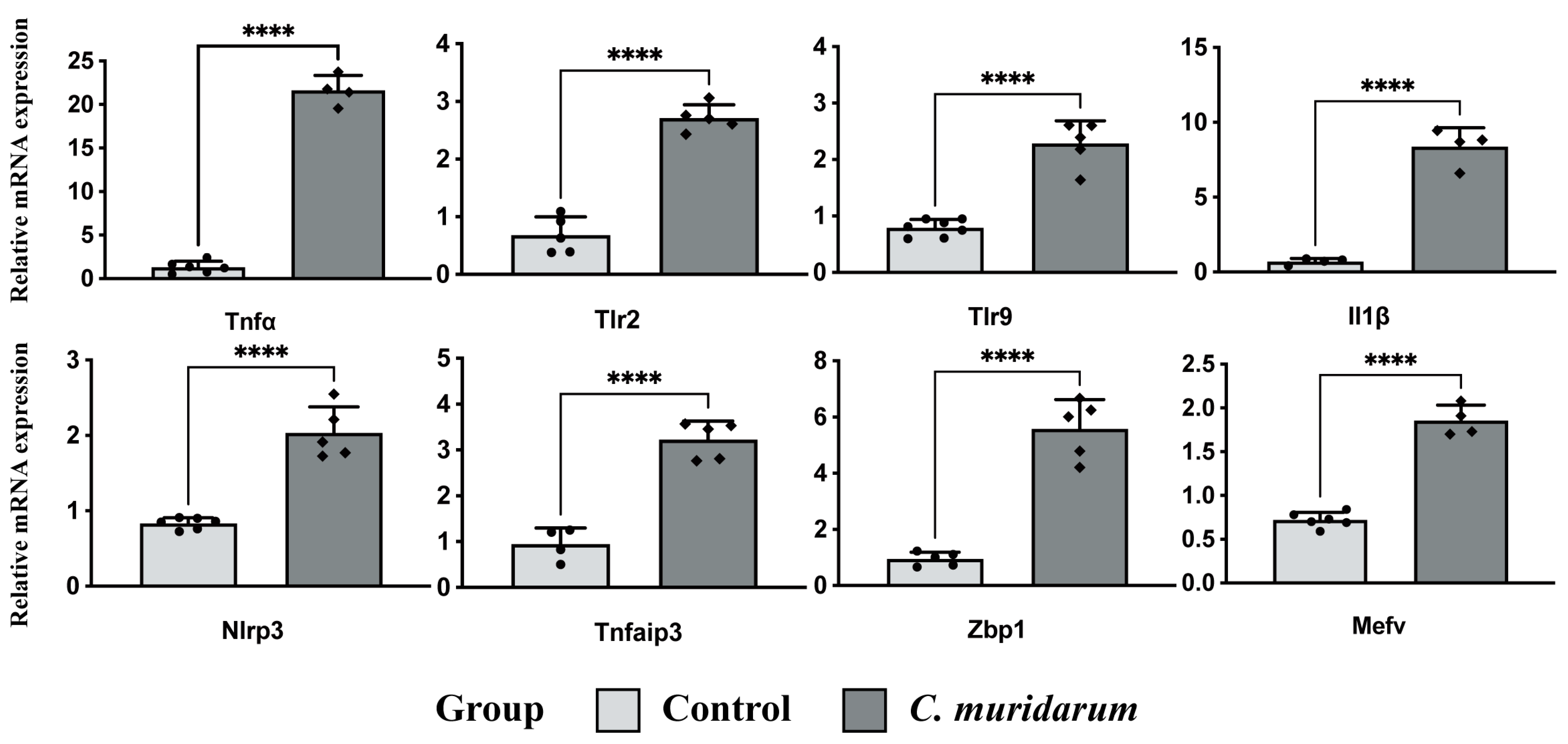
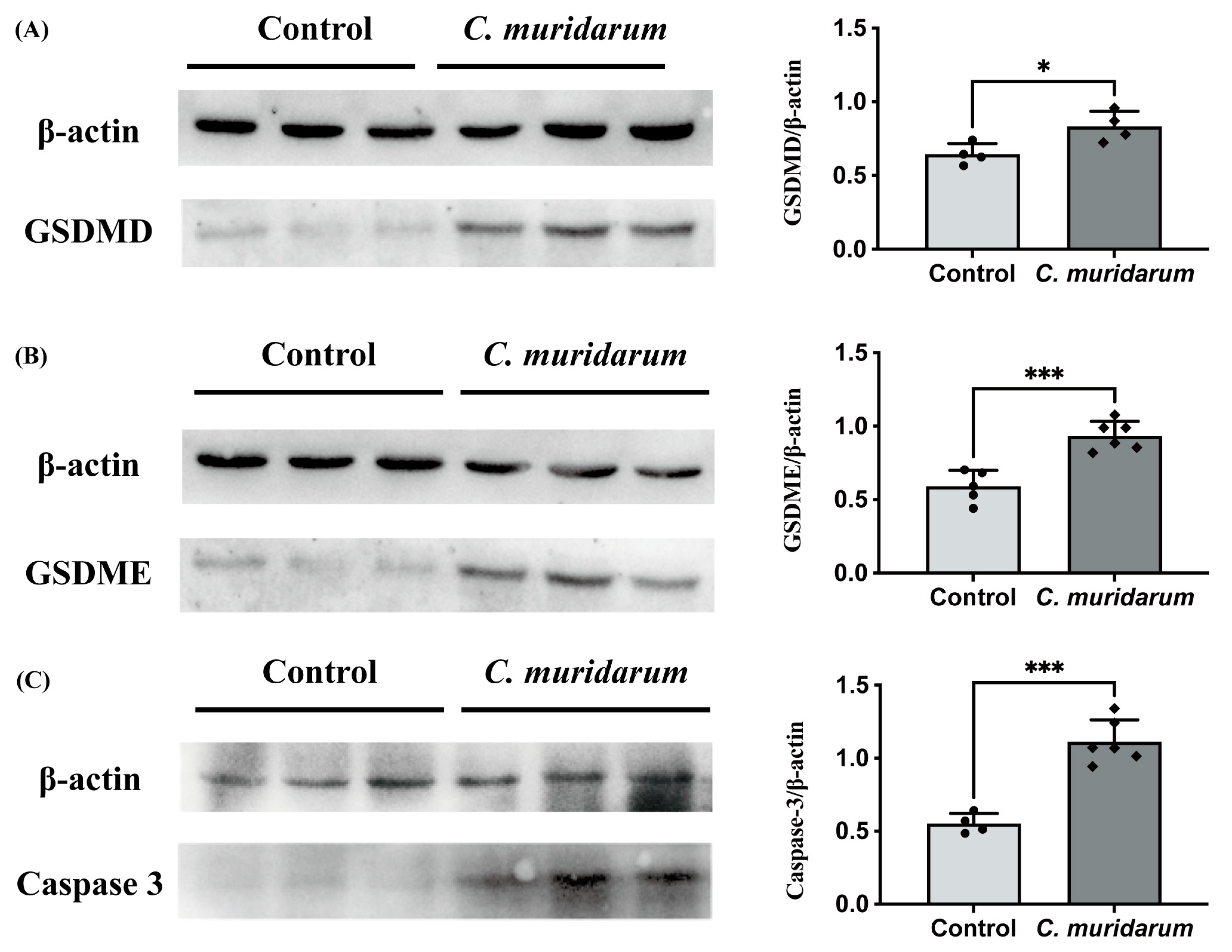
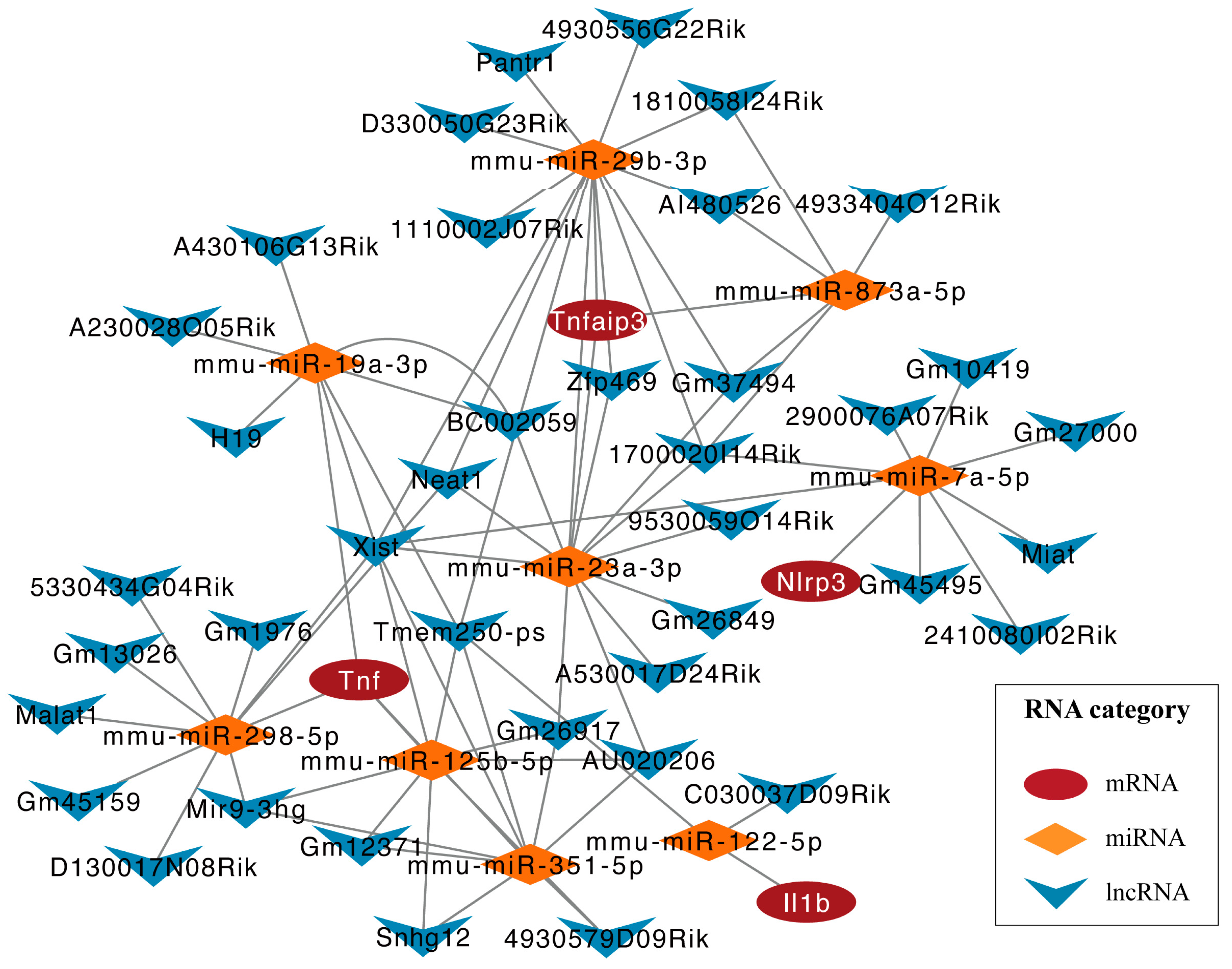
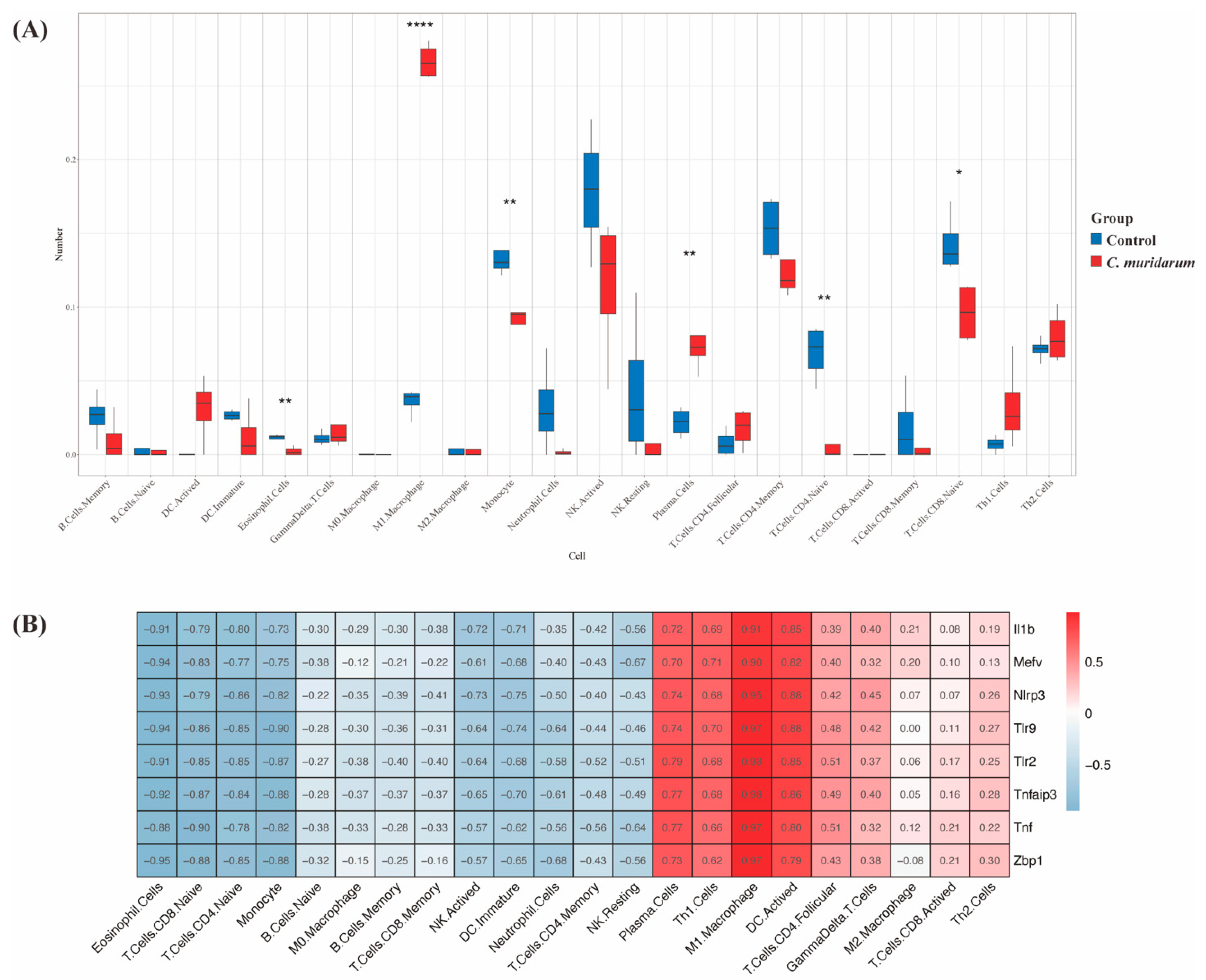
| Pathway ID | Category | Description | Count | Genes | p-Value |
|---|---|---|---|---|---|
| GO:0061702 | CC | inflammasome complex | 2 | Mefv, Nlrp3 | 4.32 × 10−5 |
| GO:0005149 | MF | interleukin-1 receptor binding | 2 | Il1b, Tlr9 | 2.31 × 10−5 |
| GO:0050727 | BP | regulation of inflammatory response | 12 | Aoah, Ccr5, Il1b, Mefv, Nlrp3, Tlr2, Tlr9, Tnf, Tnfaip3, Trem2, Zbp1, Adipoq | 1.86 × 10−22 |
| GO:0050729 | BP | positive regulation of inflammatory response | 9 | Ccr5, Il1b, Mefv, Nlrp3, Tlr2, Tlr9, Tnf, Trem2, Zbp1 | 1.31 × 10−18 |
| GO:0032611 | BP | interleukin-1 beta production | 8 | Ccr5, Il1b, Mefv, Nlrp3, Tlr2, Tnf, Tnfaip3, Trem2 | 2.28 × 10−17 |
| GO:0031349 | BP | positive regulation of defense response | 9 | Ccr5, Il1b, Mefv, Nlrp3, Tlr2, Tlr9, Tnf, Trem2, Zbp1 | 9.81 × 10−16 |
| GO:0032675 | BP | regulation of interleukin-6 production | 7 | Ccr5, Il1b, Tlr2, Tlr9, Tnf, Tnfaip3, Trem2 | 3.13 × 10−13 |
| mmu04217 | KEGG | necroptosis | 5 | Il1b, Nlrp3, Tnf, Tnfaip3, Zbp1 | 6.17 × 10−7 |
| mmu04621 | KEGG | NOD-like receptor signaling pathway | 5 | Il1b, Mefv, Nlrp3, Tnf, Tnfaip3 | 1.70 × 10−6 |
| mmu04620 | KEGG | Toll-like receptor signaling pathway | 4 | Il1b, Tlr2, Tlr9, Tnf | 2.82 × 10−6 |
| Rank | Gene Symbol | Score | Function | Gene Name |
|---|---|---|---|---|
| 1 | Tnf | 900 | Pyroptosis core components | Tumor necrosis factor |
| 1 | Tlr2 | 900 | Inflammasome | Toll-like receptor 2 |
| 3 | Il1b | 894 | Pyroptosis core components | Interleukin-1 beta |
| 4 | Nlrp3 | 864 | Inflammasome | NLR family pyrin domain containing 3 |
| 4 | Tlr9 | 864 | Inflammasome | Toll-like receptor 9 |
| 6 | Mefv | 720 | Inflammasome | Mediterranean fever |
| 6 | Zbp1 | 720 | Genes with pyroptosis function or regulate the expression of PRGs | Z-DNA binding protein 1 |
| 8 | Tnfaip3 | 120 | Genes with pyroptosis function or regulate the expression of PRGs | Tumor necrosis factor, alpha-induced protein 3 |
| mRNA | miRNA |
|---|---|
| Tnf | mmu-miR-125b-5p, mmu-miR-351-5p, mmu-miR-298-5p, mmu-miR-19a-3p |
| Il1b | mmu-miR-122-5p |
| Nlrp3 | mmu-miR-7a-5p |
| Tnfaip3 | mmu-miR-29b-3p, mmu-miR-873a-5p, mmu-miR-23a-3p |
Disclaimer/Publisher’s Note: The statements, opinions and data contained in all publications are solely those of the individual author(s) and contributor(s) and not of MDPI and/or the editor(s). MDPI and/or the editor(s) disclaim responsibility for any injury to people or property resulting from any ideas, methods, instructions or products referred to in the content. |
© 2023 by the authors. Licensee MDPI, Basel, Switzerland. This article is an open access article distributed under the terms and conditions of the Creative Commons Attribution (CC BY) license (https://creativecommons.org/licenses/by/4.0/).
Share and Cite
Sun, R.; Zheng, W.; Yang, S.; Zeng, J.; Tuo, Y.; Tan, L.; Zhang, H.; Bai, H. In Silico Identification and Validation of Pyroptosis-Related Genes in Chlamydia Respiratory Infection. Int. J. Mol. Sci. 2023, 24, 13570. https://doi.org/10.3390/ijms241713570
Sun R, Zheng W, Yang S, Zeng J, Tuo Y, Tan L, Zhang H, Bai H. In Silico Identification and Validation of Pyroptosis-Related Genes in Chlamydia Respiratory Infection. International Journal of Molecular Sciences. 2023; 24(17):13570. https://doi.org/10.3390/ijms241713570
Chicago/Turabian StyleSun, Ruoyuan, Wenjing Zheng, Shuaini Yang, Jiajia Zeng, Yuqing Tuo, Lu Tan, Hong Zhang, and Hong Bai. 2023. "In Silico Identification and Validation of Pyroptosis-Related Genes in Chlamydia Respiratory Infection" International Journal of Molecular Sciences 24, no. 17: 13570. https://doi.org/10.3390/ijms241713570
APA StyleSun, R., Zheng, W., Yang, S., Zeng, J., Tuo, Y., Tan, L., Zhang, H., & Bai, H. (2023). In Silico Identification and Validation of Pyroptosis-Related Genes in Chlamydia Respiratory Infection. International Journal of Molecular Sciences, 24(17), 13570. https://doi.org/10.3390/ijms241713570





